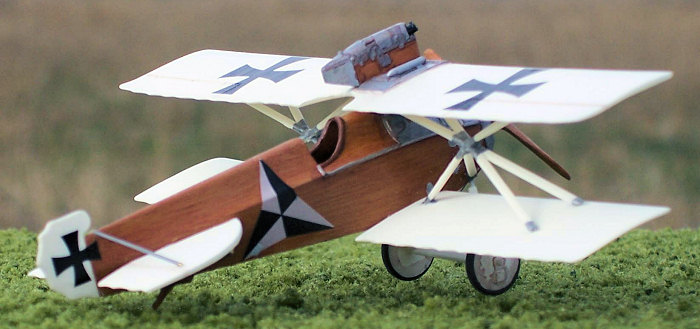
Toko/Eastern Express 1/72 Hansa-Brandenburg D.1
| KIT #: | 117/72164 |
| PRICE: | $ Kits currently out of production |
| DECALS: | Three options |
| REVIEWER: | Kyle Bodily |
| NOTES: |

| HISTORY |
Austria-Hungary entered the First World War without an indigenous fighter. It was necessary to look for a home-built fighter since Germany had become reluctant to give up its best front line fighters. Austro-Hungary began with the Phoenix built Hansa-Brandenburg D.I(Ph). The Hansa-Brandenburg D.I was initially designed as a German fighter but was not accepted and subsequently offered to the Austro-Hungarians. 50 aircraft were built by Hansa und Brandenburgische and built at their Briest facility. They were aircraft numbers 65.50 to 65.99. The remainder of the production run, some 73 airframes were completed by Phoenix and numbered 28.01 to 28.72
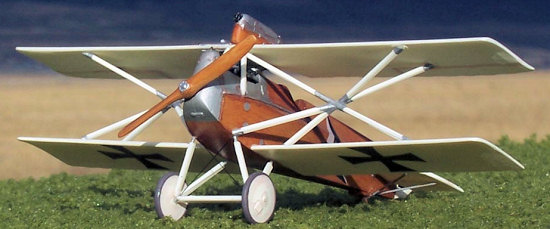 Ernst Heinkel designed the Hansa-Brandenburg
D.I. You WWII guys will recognize who Ernst Heinkel was. While Professor
Knoller designed the distinctive strut system which gave the D.I its nickname
"Starstrutter" or "Spider".
But most commonly it was just called the ďKDĒ short for Kampf Doppeldecker.
The strut system was designed as a way to reduce parasitic drag created by the
rigging wires. As it turned out, it was very strong and it did reduce drag.
However, it was heavier then conventional designs.
Ernst Heinkel designed the Hansa-Brandenburg
D.I. You WWII guys will recognize who Ernst Heinkel was. While Professor
Knoller designed the distinctive strut system which gave the D.I its nickname
"Starstrutter" or "Spider".
But most commonly it was just called the ďKDĒ short for Kampf Doppeldecker.
The strut system was designed as a way to reduce parasitic drag created by the
rigging wires. As it turned out, it was very strong and it did reduce drag.
However, it was heavier then conventional designs.
The Brandenburg was quite tricky to fly and it took the pilots full attention just to keep the aircraft under control. It had a tendency to suddenly spin, and like the Sopwith Camel it was virtually impossible to recover from this condition. Traits like this were why it became known as Totschlager or killer. Performance of the Brandenburg was discouraging. Flars ordered improvements in hopes of making it less lethal to its pilot and more lethal to the enemy. But the improvements were not totally successful and the remaining fighters were assigned to training units. In spite of not having a synchronized machine gun and poor forward visibility, the D.I was widely used by many Austro-Hungarian aces.
More D.Is were lost in accidents then in combat. Even with all these problems the Austro-Hungarians were forced to use this aircraft until the 27th of January 1918 when it was finally removed from front line service.
The D.I gave the Austro-Hungarians much needed experience in fighter production and implementation. The realization and correcting of the Hansa-Brandenburg D.Iís problems led directly to the Phoenix D.I and D.II, and they turned out to be quite successful fighters.
| THE KIT |
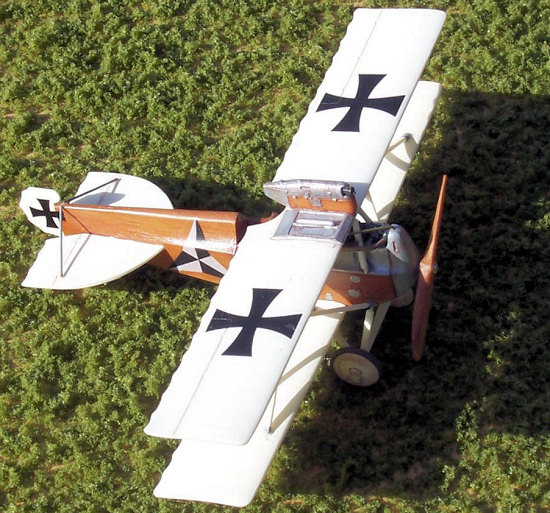 At one time this kit, along with
other really nice kits by Toko and Eastern Express, were quite common. Now they
are getting harder and harder to find. Toko and later Eastern Express were
steadily gaining a reputation for very well made and inexpensive kits of WWI
subjects. The Hansa-Brandenburg D.I was no exception. You get 39 plastic parts
to produce a KD series 28. The series 65 had a different forward fuselage. The
detailing of the fabric surfaces is quite good and not as pronounced as you may
have seen on other models. But still it is pronounced. The overall quality of
the molds is good with only a little flash and no ejector pin marks. Some of the
parts are quite petite so care will be needed removing them from the sprues.
At one time this kit, along with
other really nice kits by Toko and Eastern Express, were quite common. Now they
are getting harder and harder to find. Toko and later Eastern Express were
steadily gaining a reputation for very well made and inexpensive kits of WWI
subjects. The Hansa-Brandenburg D.I was no exception. You get 39 plastic parts
to produce a KD series 28. The series 65 had a different forward fuselage. The
detailing of the fabric surfaces is quite good and not as pronounced as you may
have seen on other models. But still it is pronounced. The overall quality of
the molds is good with only a little flash and no ejector pin marks. Some of the
parts are quite petite so care will be needed removing them from the sprues.
The instructions are the usual multiple construction sequence and are quite good. Color information is referenced to Humbrol paint and a generic name is given as well. You get a rather impressive selection of decals including wood paneling. The decals themselves look O.K but from my experience they are somewhat difficult to work with.
I have both Toko and the Eastern Express kits and I canít see any difference in them except for the color of the plastic. I also think that the Eastern Express plastic is a little harder. You get more decal options in the Eastern Express kit-some five aircraft while the Toko kit gives you decals for only two. Toko doesnít give you enough wood decals and the Brumowski swirl decals are not good at all. Now except for the wood decals, the Eastern Express decals do look better. I am going to build the Eastern Express kit because it just looks better to me.
| CONSTRUCTION |
This is a fairly simple kit. The cockpit is quite simple with only five parts making up the internals. But this is adequate since this kit is in 1/72 scale. I decided to build this kit with only the parts provided by the manufacturer. Since I am going to build the early KD, I will have to reshape the rudder since the kit comes with the late rudder and vertical stabilizer only.
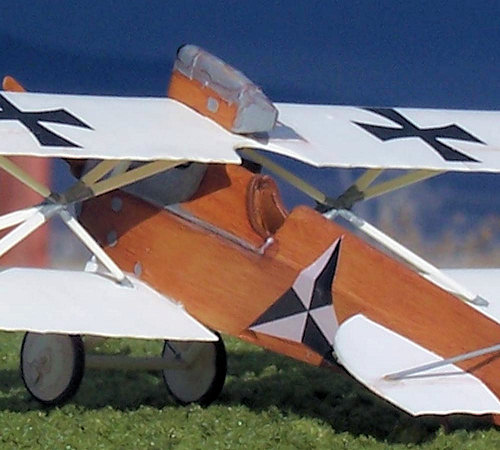 I like to paint all the like colored
stuff at the same time. I always begin with the wood. Everything that would be
wood was painted Model Masters wood. Later after the paint has dried thoroughly
I use oil paints to simulate the wood grain. The seat and control column were
painted black and gray respectively and the engine was painted black with silver
intake manifolds. I usually paint all the linen radome tan but in this case I
thought that a lighter shade would be more appropriate. So I just added white
to the radome tan until I got the color that I wanted. I then painted all the
linen parts and started to assemble.
I like to paint all the like colored
stuff at the same time. I always begin with the wood. Everything that would be
wood was painted Model Masters wood. Later after the paint has dried thoroughly
I use oil paints to simulate the wood grain. The seat and control column were
painted black and gray respectively and the engine was painted black with silver
intake manifolds. I usually paint all the linen radome tan but in this case I
thought that a lighter shade would be more appropriate. So I just added white
to the radome tan until I got the color that I wanted. I then painted all the
linen parts and started to assemble.
I think that this kit went together quite well until I got to the struts and mounting the top wing. I think that the struts are a little short as I test fit them. I think that they will still work if I jig the wings and set the struts on the top wings first. What I ended up doing was to move the outer strut attachment points in just a little and it actually worked. Sure I didnít use the locator pins and holes, but it seemed to work all the same and more importantly I think it looks good.
Now for the one part that I had to modify. I went to the copy store and burned off a copy of the rudder in 1/72 scale. I glued the copy of the early rudder to the kitís rudder with white glue. I just filed away all the plastic that didnít look like the early rudder, it was just that easy.
| COLORS & MARKINGS |
The decals are for aircraft 28.15, 28.33, 28.44, 28.65 and 28.69. I would personally suggest that you donít use the wood paneling decals and paint the wood. I think that painting the wood would look better. I think that I will just use the crosses from this kit and some others from my decal stash.
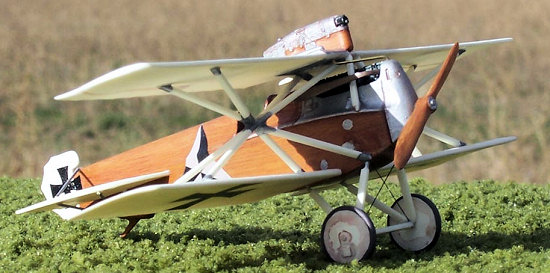 I am going to build aircraft 28.10.
This was the first personal aircraft of Feldpilot Hauptmann Godwin
Brumowski while serving with Flik 41/J. It was finished in the standard
finish of a clear varnished wood fuselage with clear doped linen wings and tail
surfaces. I also plan to build the early version with the small rudder and no
vertical stabilizer. This is how 28.10 would have appeared 10 May 1917 when he
scored the first of four victories in this aircraft. Three confirmed and one
non-confirmed. Godwin went on to score 17 victories total in KDs
I am going to build aircraft 28.10.
This was the first personal aircraft of Feldpilot Hauptmann Godwin
Brumowski while serving with Flik 41/J. It was finished in the standard
finish of a clear varnished wood fuselage with clear doped linen wings and tail
surfaces. I also plan to build the early version with the small rudder and no
vertical stabilizer. This is how 28.10 would have appeared 10 May 1917 when he
scored the first of four victories in this aircraft. Three confirmed and one
non-confirmed. Godwin went on to score 17 victories total in KDs
I used the crosses from the kit and they worked O.K. I had to use smaller cress for the tail that I got from my old decal stash. The personal markings were from an old Blue Rider decal sheet. The only rigging that was needed was for the undercarriage and rudder.
| CONCLUSIONS |
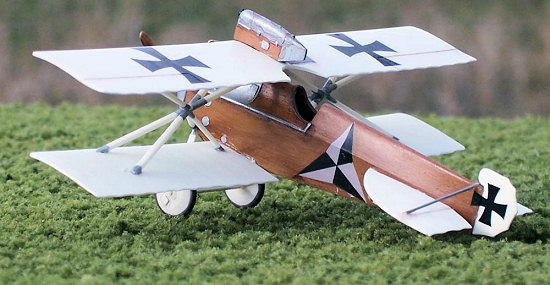 This kit got a little difficult when
it came to the struts. Other then that it was not bad. I would still consider
it a limited run kit with all the accompanying challenges. The other positive
was that because of the unique strut design you will not have to do much
rigging. You could look at it this way, if you take away the difficulty of
rigging and add the difficulty of the struts, I think you could say that it is
about the same as any other WWI kit.
This kit got a little difficult when
it came to the struts. Other then that it was not bad. I would still consider
it a limited run kit with all the accompanying challenges. The other positive
was that because of the unique strut design you will not have to do much
rigging. You could look at it this way, if you take away the difficulty of
rigging and add the difficulty of the struts, I think you could say that it is
about the same as any other WWI kit.
I have built many of the old Toko and Eastern Express kits and I like them. They were of unique subjects seldom if ever kitted as injection molded models. Above all they were the best and most accurate kits of their particular subjects that I know of. I donít know who has the molds for these models but it would be good to see these kits on the model store shelves again.
| REFERENCES |
(Air Aces of the Austro-Hungarian Empire 1914-1918) by the late Dr. Martin OíConner
(Brandenburg D.I by) by Karl Meindl and Walter Schroeder
(Austro-Hungarian Army Aircraft of World War One) by Peter M. Grosz, George Haddow and Peter Schiemer
November 2006
Copyright ModelingMadness.com. All rights reserved. No reproduction in part or in whole without express permission.
If you would like your product reviewed fairly and fairly quickly, please contact the editor or see other details in the Note to Contributors.